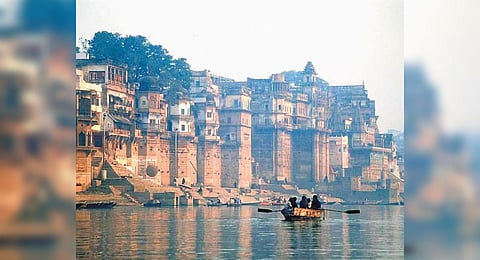

In ancient times, great civilisations arose on the banks of large rivers that provided ample water for agriculture. For example, the Egyptians had the Nile, the Mesopotamians had the Tigris and Euphrates, and the Chinese had the Huang He. In India, the Indus Valley Civilisation grew on the banks of the Indus, while the Vedic civilisation prospered along the Ganga. With rivers sustaining and nurturing life, it is no wonder that they have been regarded in Hindu mythology as holy, living entities with divine powers.
The earlier hymns of Rigveda most frequently praise the Indus and the Saraswati, while the later ones often praise the Ganga. The term Sapta Sindhu or seven sacred rivers is mentioned frequently in Hindu texts. There is no unanimity on the names of the seven rivers, but the most mentioned are Indus, Saraswati, Ganga, Yamuna, Godavari, Narmada and Cauvery.
A story in the Rigveda states that the rivers were captured by the danava Vritra, who was drought personified. To release the rivers, Indra fought with Vritra for 360 days. Finally, Indra smashed the 99 fortresses of Vritra and killed him with the thunderbolt, Vajra, made from the bones of Rishi Dadhichi.
Sometimes, rivers are avatars of divine beings. For example, the river known today as Kosi, which flows through China, Nepal and India, was earlier known as Kausiki and believed to be the form taken by Satyavati after her death. Satyavati was the elder sister of the famous Rishi Vishwamitra and belonged to the Kushak dynasty. In her human form, Ganga was the wife of Kuru King, Shantanu, and the mother of Bhishma.
The largest religious gathering on earth is the Kumbh Mela which is held every third year at four places in rotation. All these places are closely connected to rivers. Haridwar is where the Ganga descends from the hills into the plains, Prayag is where the Ganga meets the Yamuna and the Saraswati, Nashik is on the banks of Godavari and Ujjain lies on the Shipra River. Similarly, the ‘Char Dham’ yatra is also closely associated with rivers. It includes Gangotri (the origin of the Ganga), Yamunotri (the origin of the Yamuna), Badrinath (the origin of the Alakananda) and Kedarnath (the origin of the Mandakini).
The holiest river in Hinduism is the Ganga which is invoked whenever water is used in a religious ceremony. The Ganga is mentioned in the Ramayana, the Mahabharata and the Puranas as having descended onto earth from the heavens. Since Ganga has descended from the heavens, she can also take the dead to heaven. Hence, Hindus desire that they be cremated along the banks of the Ganga or at least their ashes be immersed in it. A bath in the Ganga is believed to remove all of one’s sins.